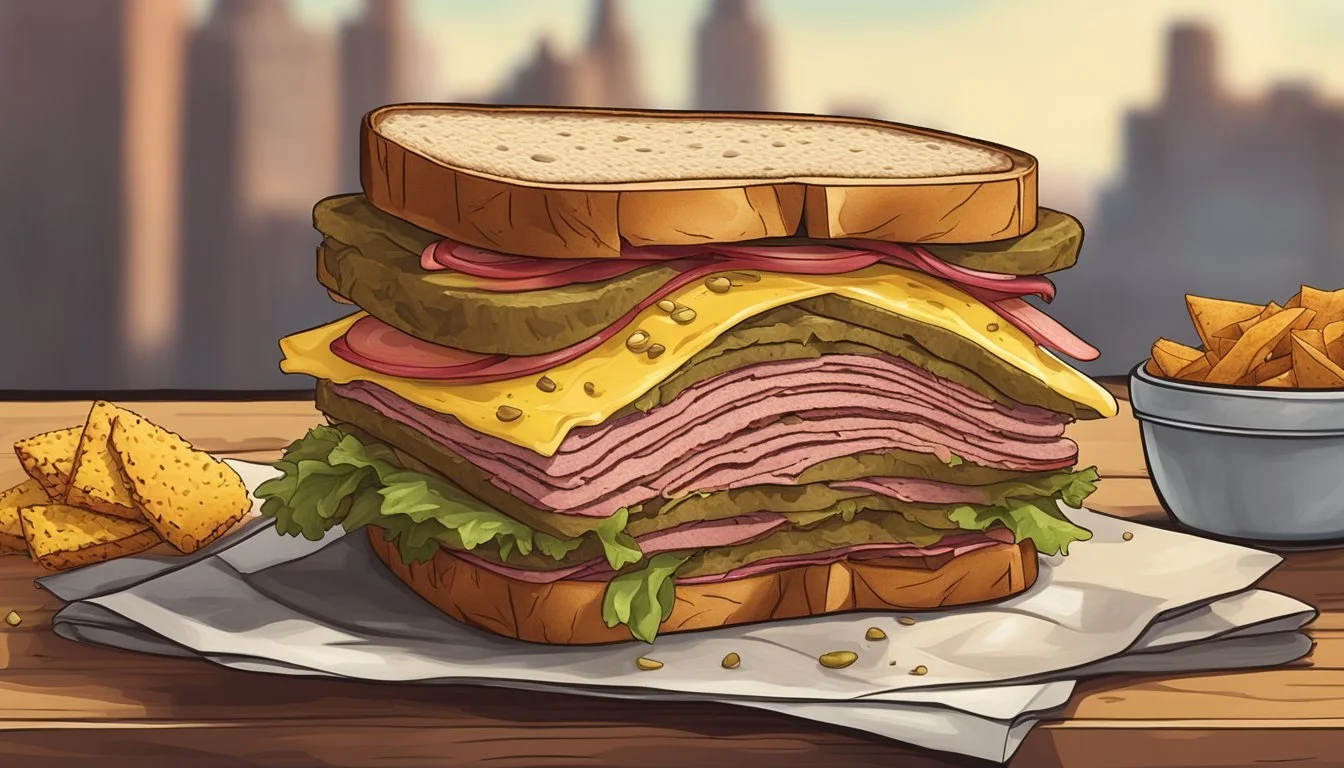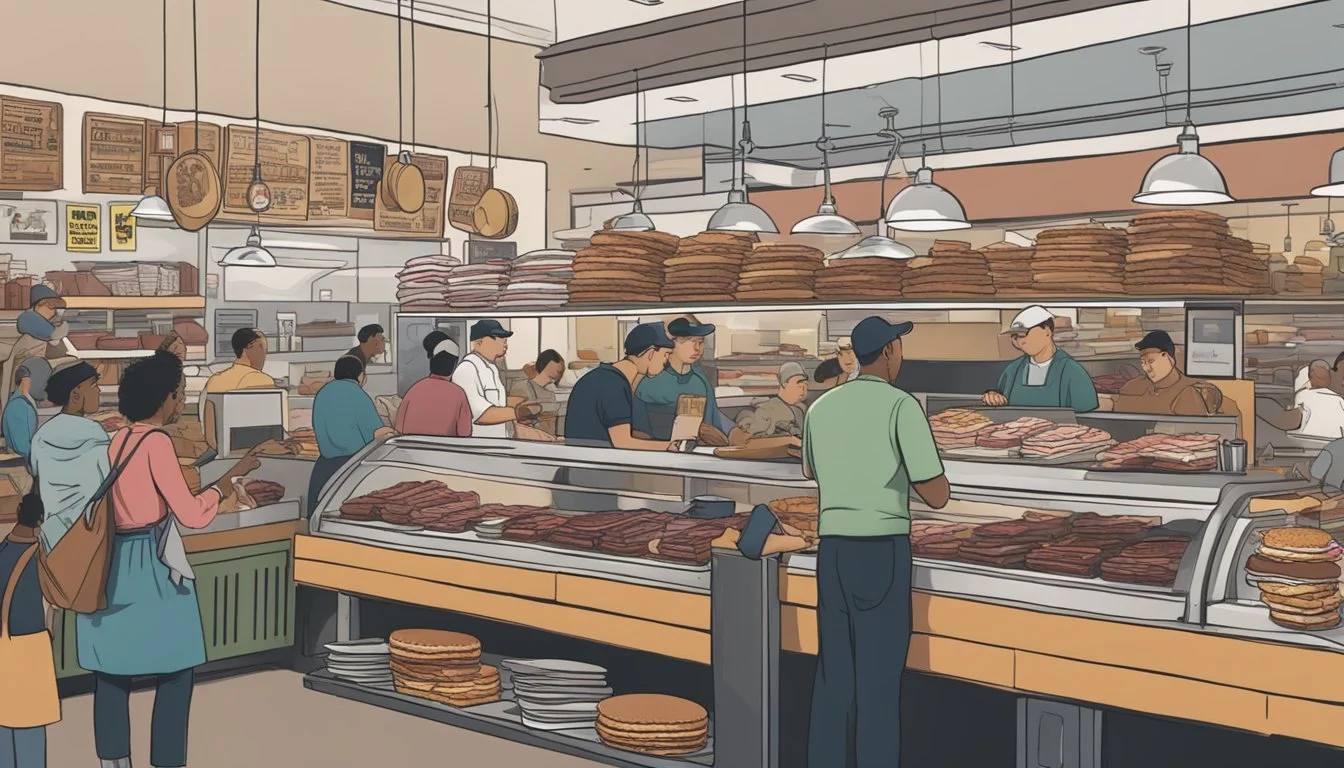New York: The Pastrami Sandwich Challenge
Finding the City's Best Deli Classic
New York City, colloquially known as the Big Apple, has long been celebrated for its diverse culinary scene. Among its many contributions to the world of gastronomy, the pastrami sandwich stands out as a quintessential New York delicacy. The pastrami sandwich is not merely a meal; it's an institution, embedded deeply in the city's cultural fabric. Patrons flock from far and wide to indulge in the tender, spiced meat, often piled high between slices of fresh rye bread.
Tackling the Pastrami Sandwich Challenge in New York is a rite of passage for both tourists and locals alike. Every deli seems to have its own secret recipe and method for curing, smoking, and slicing the pastrami, resulting in a range of flavors and styles unique to each establishment. The sandwiches (What wine goes well with sandwiches?) are celebrated for their generous servings of pastrami, which require a certain level of skill and commitment to conquer.
As enthusiasts explore the city's delis, they find themselves immersed in a decades-old tradition. Renowned establishments like Katz's Delicatessen have been serving pastrami sandwiches that are as integral to New York's identity as the skyline itself. Whether the preference is for a classic presentation or a more modern interpretation with novel accompaniments, each sandwich offers a savory slice of the city's collective history and culinary prowess.
History of the Pastrami Sandwich
The pastrami sandwich, a staple of New York cuisine, has a rich history intertwined with Jewish immigrants and has become iconic in popular culture, notably appearing in films like "When Harry Met Sally."
Origins and Jewish Immigrants
Pastrami finds its historical origins in Romania where it was traditionally made from goose. Immigrants from Eastern Europe brought the pastrami tradition to America, adapting it with beef brisket (What wine goes well with beef brisket?) due to the scarcity of goose. They would soak brisket in a brine before smoking and slicing it for preservation. These Jewish immigrants settled on the Lower East Side, among other areas, establishing the pastrami sandwich as a New York deli staple.
New York's Deli Culture Evolution
The delis of New York, especially those on 2nd Ave, became cultural hubs where the pastrami sandwich grew in popularity. This evolution saw the sandwich moving from a means of meat preservation to a beloved feature on the menus of many New York eateries. The pastrami sandwich became synonymous with the New York deli experience, exemplified by thick-cut, juicy meat layered between slices of rye bread and often accompanied by a smear of mustard.
Famous Pastrami Scenes
The pastrami sandwich achieved celebrity status in popular media, most notably in a scene from the romantic comedy When Harry Met Sally, filmed at Katz's Delicatessen in Manhattan. Katz's Deli, in particular, has been serving pastrami sandwiches since 1888 and has cemented the food's status in American culture. This iconic scene showcased the pastrami sandwich as a symbol of New York's culinary prowess and an inseparable part of its cultural identity.
The Art of Making Pastrami
The process of creating pastrami, a tantalizing deli favorite, entails a meticulous approach from selecting high-grade beef brisket to achieving that signature smoky flavor and tender texture through brining, seasoning, smoking, and steaming.
Selecting the Meat
Pastrami begins with high-quality beef brisket. Butchers look for a cut that has a good balance of meat to fat, ensuring that the final product is both juicy and flavorful. The fatty portions are crucial, as they contribute moisture and taste during the cooking process.
The Brining Process
Brining is a critical step where the brisket is soaked in a solution of water, salt, and curing agents for several days. This not only seasons the meat but also starts to tenderize it.
Prepare brine solution with:
Water
Salt
Sugar
Curing salt (sodium nitrite)
Submerge brisket in brine for:
5-7 days (for optimal flavor penetration)
Spices and Flavoring
Following the brine, the beef brisket is coated with a spice mixture that almost always includes coriander and black pepper. These spices create a crust on the meat during the smoking process, sealing in the flavors and contributing to pastrami's unique taste.
Essential spices:
Coriander seeds (lightly crushed)
Black pepper (coarsely ground)
The Smoking Technique
The smoked characteristic of pastrami is achieved by slowly cooking the meat in a smoker. Wood chips or smoke from hardwoods like hickory or oak envelop the meat, infusing it with a distinctive smoky flavor. Smoking duration will vary, but typically the brisket is smoked until it reaches an internal temperature that ensures perfect tenderness.
Smoking temperature:
225°F (107°C)
Internal temperature target:
190°F (88°C)
Steaming to Perfection
Steam is the final guardian of pastrami's moisture and texture. Once the meat is adequately smoked, it's transferred to a steamer where it relaxes and becomes melt-in-your-mouth tender. This can take several hours, but patience is key to delivering that classic New York pastrami experience.
Steaming time:
2 to 3 hours
Key Ingredients of a Pastrami Sandwich
In crafting the perfect Pastrami Sandwich, each ingredient plays a pivotal role in creating its quintessential New York flavor. From the importance of the rye bread's crust to the tang of the mustard and the crunch of the pickles, every element deserves attention.
The Rye Bread
The foundation of any authentic Pastrami Sandwich is rye bread, notable for its firm texture and distinctive flavor. A high-quality rye will usually have a crust that's crispy and a crumb that stands up to the moisture of the pastrami and condiments without becoming soggy.
Mustard Varieties
Mustard is a key player, providing an essential spice and sharpness that cuts through the richness of the meat. Traditional choices include:
Classic yellow mustard, for its bright tang and smooth consistency.
Spicy brown or deli-style mustard, offering a more robust and fiery taste.
Adding the Pickles
Pickles contribute a necessary acidity and crunch to the sandwich. Sliced dill pickles are most common, but some connoisseurs may opt for gherkins or even pickled green tomatoes.
The Cheese Debate
While not traditional, some variations introduce cheese to the equation, with Swiss cheese being a popular choice for its mild flavor and meltability that doesn't overpower the pastrami.
Additional Dressings
Finally, while purists may insist on mustard only, additional dressings like Russian Dressing or Sauerkraut can be included to complement the meat’s flavor profile:
Russian Dressing: A mix of ketchup, mayonnaise, and spices for a creamy, tangy kick.
Sauerkraut: Adds a fermented sharpness that enhances the overall savor of the sandwich.
Iconic Delis and Locations
New York City is renowned for its delis, each offering a unique take on the classic pastrami sandwich. From the Upper East Side to the Lower East Side, these eateries serve up history and flavor in equal measure.
Upper East Side
Pastrami Queen is a staple for residents and visitors alike, offering a renowned pastrami sandwich that's a must-try for any enthusiast of the New York deli scene.
Barney Greengrass, known for its status as the "Sturgeon King," also provides a memorable pastrami experience alongside its famed fish selections.
Flatiron and Murray Hill
In the heart of the Flatiron district, pastrami fans can indulge at the 2nd Ave Deli, a kosher deli that has been a part of New York's culinary history since 1954. Initially located in the East Village, this deli maintains its heritage even after relocating, serving up savory pastrami sandwiches to a loyal following.
Lower East Side Gems
The Lower East Side is home to some of the most famous delis in the world, with Katz's Delicatessen leading the charge as a legendary venue for authentic New York pastrami. Its cavernous cafeteria is a true repository of New York history.
For a list of other outstanding pastrami sandwiches in the area, New Yorkers often refer to Eater NY's ranking, which features a selection of outstanding Lower East Side locations.
Expanding Beyond Manhattan
While Manhattan has a monopoly on fame for the pastrami sandwich, the love for this iconic dish spreads across boroughs. Additional delis beyond the island maintain the high standards set by their Manhattan counterparts, making the pastrami sandwich a unifying culinary delight for the city. Whether it's a new-age interpretation or a classic recipe, these delis celebrate the rich tradition that is as diverse as New York itself.
The Pastrami Sandwich Experience
Exploring the pastrami sandwich in New York is a journey through taste and tradition, showcasing thick cuts of pastrami, often complemented by tangy sauerkraut and smooth Russian dressing.
The Perfect Pastrami Bite
The quintessential pastrami bite delivers a balance of flavors and textures. It features succulent, spiced beef brisket that has been smoked and steamed to perfection, layered between slices of rye bread that offer a slight crunch. The meat, typically served at room temperature, contrasts beautifully with the warm bread. Some of New York's best pastrami sandwiches are known for their generous meat servings, making each bite a hearty experience.
Side Dishes and Complements
Pastrami sandwiches are often accompanied by a pickle, elevating the flavors with their acidity. Here's a list of common sides:
Pickle: A deli classic that introduces a vinegar kick.
French fries: Crispy and comforting, an American staple.
Cole slaw: Creamy with a hint of sweetness, offering a refreshing contrast.
Potato salad: A creamy counterpart with soft, comforting chunks of potato.
These sides act as the perfect foil to the savory richness of the pastrami.
Cultural and Culinary Impact
The pastrami sandwich is more than just lunch; it's an emblem of New York's culinary mosaic. Renowned New York delis contribute to the city's cultural fabric, inviting everyone to savor this flavorful innovation. Toppings like sauerkraut, offering probiotic benefits and a tangy zest, and Russian dressing, with its creamy texture and peppery undertones, enhance the pastrami's spiced crust — a testament to the city's history of immigration and culinary fusion.
Variations and Innovations
Exploring New York's pastrami scene reveals not just classic sandwiches, but also a world of creativity that pushes beyond traditional boundaries. Chefs innovate with pastrami in non-sandwich dishes, fuse it with international flavors, and cater to health-conscious diners looking for lighter fare.
Pastrami Beyond the Sandwich
While the pastrami sandwich remains a staple of New York cuisine, chefs have begun serving pastrami as a main course, often drawing inspiration from the city's oldest lunch counters. Pastrami finds new life plated with a side of traditional sides like potatoes and vegetables, recalling the hearty, immigrant roots of New York's culinary history. In barbecue, it's not uncommon to see pastrami making a smoky, spiced appearance alongside ribs and brisket.
Fusion and Cross-Cultural Creations
Fusion dishes that incorporate pastrami are a testament to New York's melting pot of cultures. For example, some local eateries present a twist on the classic burger by topping it with pastrami, marrying American fast food with Jewish deli tradition. Further blending culinary worlds, pastrami tacos have emerged, featuring the seasoned, smoked meat inside soft tortillas, adorned with a mix of traditional Mexican ingredients and Jewish condiments like sauerkraut or mustard.
Health-conscious Alternatives
Noticing a demand for healthier options, delis have introduced lighter variants of the conventional pastrami dish. A Pastrami Reuben may be reimagined with turkey pastrami instead of the classic beef and served with a tangy coleslaw, cutting down on fat without compromising on flavor. Others have crafted vegetarian or vegan versions of the pastrami sandwich, using seasoned vegetables or plant-based meats to mimic the texture and taste that pastrami lovers expect.
Critical Acclaim and Reviews
New York's pastrami sandwiches have garnered attention from reputable food critics and are a vibrant topic on social media, reflecting their importance in the culinary world of the city.
Influential Food Critics
Critics such as Robert Sietsema have become trusted voices in the New York food scene, evaluating the city's best pastrami sandwiches. His rankings influence diners' choices and highlight the craftsmanship of iconic establishments. Another esteemed critic, Nick Solares, is well-known for his expertise and passionate reviews on the New York pastrami sandwich, often focusing on the quality of the meat and the overall sandwich construction.
Pastrami on Social Media
Social media platforms are a battleground where patrons and enthusiasts discuss and share their pastrami sandwich experiences. Instagram and Twitter are teeming with high-resolution images and real-time reviews of New York's best offerings. Local delis in neighborhoods like Red Hook often feature in these online conversations, with places like Hometown acquiring fame not only for their sandwiches but also for their vibrant community presence.
DIY Pastrami Making
Creating your own pastrami at home can be an immensely rewarding experience, offering a taste that's uniquely yours while paying homage to the beloved deli classic. Mastering the art of pastrami involves smoking succulent beef brisket and implementing key techniques to nail that signature deli flavor.
Home Smoking Setups
To smoke pastrami, one needs a reliable smoking setup. Options range from traditional charcoal smokers to electric or gas smokers, each providing different benefits. Charcoal smokers, like the Weber Smokey Mountain, are praised for imparting a deep smoky flavor, whereas electric smokers offer precise temperature control, and gas smokers provide ease and convenience. Whichever one chooses, maintaining a steady low temperature (225-250º F) is crucial for the perfect pastrami.
Sourcing Ingredients
The journey to delicious pastrami commences with choosing the right beef brisket. A fat-trimmed, well-marbled cut is ideal. One can locate quality brisket at local butchers or specialty meat markets. Notably, the spice rub is essential; a blend of coriander, black pepper, garlic powder, onion powder, mustard seed, and paprika is traditionally used. High-quality spices can make a significant difference, as observed on platforms showcasing easy homemade pastrami.
Recreating the Deli Flavor at Home
Recreating traditional deli flavor involves two critical stages: curing and cooking. The brisket must first be cured with a mix of pink curing salt and flavorful spices, which can take several days. The next step is to develop a rich bark and smoky essence by smoking the meat. Tips from Smoked BBQ Source clarify that after reaching an internal temperature around 150-155°F, wrapping the brisket in foil and continuing to cook until it hits 203°F will ensure tenderness. For those who lack an outdoor smoker, replicating the deli touch indoors can be achieved through methods such as oven-steaming, which is demonstrated in a variety of pastrami recipes found online.
Economic Aspects of Pastrami
The economics of pastrami in New York hinge on various cost factors and the positioning of pastrami as a desirable, sometimes luxury, delicatessen item. These facets together influence its pricing and its status as a New York Delis staple.
Cost Factors and Pricing
The price of pastrami in New York delis is shaped by several cost factors. Firstly, the quality of the meat, typically beef brisket, is paramount. The brisket undergoes a lengthy process of curing, smoking, and steaming, which involves significant time and labor costs. Additionally, the spices for the distinctive pastrami crust, such as coriander and black pepper, contribute to the overall expenses.
Next, operational costs for running a deli in New York, which can include rent, utilities, and staff wages, are factored into the price. For instance, a classic pastrami sandwich might see its price affected by the fluctuating costs of these inputs.
The New York Times notes that the price for a pastrami sandwich has seen significant rises over the years, demonstrating the impact of these varying economic pressures.
Pastrami as a Luxury Item
Pastrami can also be considered a luxury item in the context of New York delis. Its status is elevated not just by the quality and specificity of the preparation process but also by its cultural history. The balance of supply and demand can further cement pastrami's luxury status, particularly when paired with the nostalgia and authenticity a storied deli might hold in the culinary landscape of the city.
Certain delis have established themselves as iconic, using the craftsmanship behind their pastrami sandwiches to justify higher prices. Articles like those found in Eater NY highlight the emphasis placed on pastrami quality and the competitive nature of the deli scene, reinforcing the idea that pastrami is more than just sustenance; it's a specialty food experience.
Conclusion
In the landscape of New York's culinary offerings, the pastrami sandwich stands out as a symbol of the city's rich deli tradition. These delis, many with a history spanning over a century, have perfected the art of the sandwich, particularly when pastrami is the star.
The pastrami sandwich in New York offers more than just a meal—it's an experience that encapsulates the city's diversity and the history of its immigrant populations. Delis across the five boroughs compete to claim the title of the best pastrami sandwich, with each establishment bringing its unique take to this beloved classic.
Connoisseurs of pastrami sandwiches might argue that the ideal version is one with succulent, perfectly seasoned meat, ripe with the smoke and spice that are its signature attributes. When wedged between two slices of fresh rye bread, possibly adorned with a dollop of mustard, the sandwich transforms into a quintessential New York delight.
Some of the city's top delis have been hailed for their mastery of pastrami, crafting sandwiches that resonate with both locals and visitors alike. The debate over whose pastrami reigns supreme is a testament to the sandwich's pivotal role in the culinary tapestry of New York.
Key Feature
Iconic pastrami on rye
Affordable pastrami offerings
Traditional Jewish deli experience
They serve as the battlegrounds for this ongoing pastrami challenge, each inviting patrons to savor their crafts and partake in a piece of New York's gastronomic saga.





